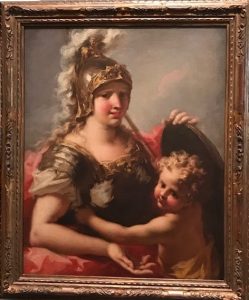
Artist: Bellona is an exquisite painting by Giovanni Antonio Pellegrini, one of the great Venetian decorative painters of the 18th Pellegrini was born in Venice, Italy in April of 1675. He began his artistic journey in Milan where he trained and apprenticed under the Milanese Paolo Pagani (Sphinx Fine Art 2012). Although he spent much of his time with Pagani, Pellegrini derived much of his influence from Sebastiano Ricci, another Venetian great, whose ‘sensuous and decorative aspects’ were a heavy part of Pellegrini’s paintings (Blanton Museum). Pellegrini gained much experience with mythological painting during his time in Venice, especially subjects from Ovid (George Knox 1995). George Knox, who is responsible for the first Antonio Pellegrini biography book, details the amazing painting career of Pellegrini and how many of his paintings “[celebrated] famous women” (George Knox 1995, 62).
Date of Creation: The Bellona was painted circa 1713-1714 and was acquired by the University of Texas’ Blanton Museum in 1998 as a part of the Suida-Manning Collection, which was gift from each respective family involved (Magazine Antiques 2014).
Location on Campus: This collection, which is located in the European section of the Blanton Museum, was accumulated by the Suida-Manning family, both of which are respected art historians, who purchased each piece as they studied it.
Acquisition Information: Together, Wilhelm Suida, his daughter Bertina Manning, and his son-in law Robert Manning acquired 240 paintings and 390 drawings. Unfortunately, all three passed away before Bertina and Robert’s daughter, Alessandra Manning Dolnier, “sold and gifted” the collection as a whole to the University of Texas in 1998 (Magazine Antiques 2014).
Description: Bellona is a 35 ½” x 29” oil on canvas painting depicts a powerful woman figure, wearing armor and holding a shield, with a baby on her lap (Giovanni Antonio Pellegrini).
This woman figure is denoted as being Bellona, the Roman goddess of war. Her Greek counterpart would be that of Enyo, who happened to be the female counterpart and close companion of the god of war, Ares (Theoi). Together, Bellona and Enyo are both well-known for their ruthlessness in war. In Quintus Smyrnaeus’ epic, The Fall of Troy, he details, “… deadly Enyo, her shoulders and her hands blood-splashed, while fearful sweat streamed from her limbs” (Quintus Smyrnaeus The Fall of Troy Book 8, 286). In the Roman poet Ovid’s Metamorphoses, he writes, “Bellona fouled the gods of hearth and home with flooding gore and stirred fresh scenes of violence” (Ovid Metamorphoses Book 5, 155). These descriptions do not seem to match the depiction by Pellegrini. He provides a more romantic perspective of Bellona. Pellegrini does an excellent job of capturing the beauty of Bellona through his use of vibrant colors and sensual style, both of which are his signatures (Sphinx Fine Art). I believe he works to portray Bellona as an inspiring figure, more of a ‘protectress of the innocent’ figure. This is exemplified by her clothing and the baby at her lap. As previously stated, Bellona is dressed in full armor with a shield. At the top of her helmet, there appears to be a small Eros-like figure, which could have been implemented to show that Bellona is from a divine lineage of Jupiter via Juno. The red-cheeked baby on her lap would be considered the symbol of innocence within this piece. Rather than depicting her renown merciless aspect, Pellegrini opts to display Bellona as more of an inspirational figure towards the innocent. This idea is not far off from her character. Statius, another renown Roman poet from the 1st century AD, writes an account of Bellona in He writes, “…[Bellona] gives swords to hurrying warriors… the brave anticipate her promptings and even the timid are inspired to… valour” (Statius Thebaid Book 4, 5). Pellegrini is able to expertly illustrate this notion through the symbol of the baby.
Bibliography:
- “Bellona · Blanton Museum of Art Collections.” 2019. Omeka RSS. Accessed April 25. http://utw10658.utweb.utexas.edu/items/show/2860.
- “ENYO.” ENYO – Greek Goddess of War (Roman Bellona). 2017. Accessed April 26, 2019. https://www.theoi.com/Daimon/Enyo.html.
- “Giovanni Antonio Pellegrini (Venice 1675 – Venice 1741).” Giovanni Antonio Pellegrini (Venice 1675 – Venice 1741) – Sphinx Artist Detail. 2012. Accessed April 25, 2019. http://www.sphinxfineart.com/Pellegrini-Giovanni-Antonio-DesktopDefault.aspx?tabid=45&tabindex=44&artistid=29455.
- Knox, George. Antonio Pellegrini. New York, New York: Oxford University Press, 1995.
- Ovid, 43 B.C.-17 A.D. or 18 A.D. Ovid’s Metamorphoses. Dallas, Tex. :Spring Publications, 1989.
- Quintus, and Arthur S. Way. Quintus Smyrnaeus: The Fall of Troy. Book 8. Cambridge, MA: Harvard University Press, 1962.
- Stace, Shackleton Bailey D. R., and P. Papinius Statius. Thebaid. Book 4. Cambridge, MA: Harvard University Press, 2003.
- “Suida-Manning Collection at the Blanton Museum.” 2017. The Magazine Antiques. Editorial Staff. January 26. Accessed April 24. http://www.themagazineantiques.com/article/old-masters-at-the-blanton/.
Written by Christian Reyes


















 Although Greek drama, particularly tragedies, were often set in the heroic world of Greek myth, they were used as a way of investigating contemporary Greek issues. Many of the narratives of Greek myth that are preserved in the writings of mythographers are based on the dramatic tellings of Greek myths by Athenian tragedians, such as Aeschylus, Sophocles, and Euripides. In Greek myth, the dramatic arts of poetry, music, and dance were said to be inspired by female deities called
Although Greek drama, particularly tragedies, were often set in the heroic world of Greek myth, they were used as a way of investigating contemporary Greek issues. Many of the narratives of Greek myth that are preserved in the writings of mythographers are based on the dramatic tellings of Greek myths by Athenian tragedians, such as Aeschylus, Sophocles, and Euripides. In Greek myth, the dramatic arts of poetry, music, and dance were said to be inspired by female deities called  Greek comedies generally had far less to do with myth than the genres of Greek tragedy and satyr. The early Greek comedies were mainly satirical, mocking political figures and people of importance for their vanity and foolishness. Our primary example of comedy is from the playwright Aristophanes. One the few examples of Greek comedies with an extended treatment of characters in Greek myth is Aristophanes’ Frogs. Frogs tells the story of how the god Dionysus travels to the underworld to bring the tragedian Euripides back from the dead because of the poor quality of Athens’ living tragedians. The potential for irreverent depictions of the gods can be observed in the character of the god Dionysus, whose behavior and numerous errors along the way to the home of Hades provide the primary source of humor in this comedy.
Greek comedies generally had far less to do with myth than the genres of Greek tragedy and satyr. The early Greek comedies were mainly satirical, mocking political figures and people of importance for their vanity and foolishness. Our primary example of comedy is from the playwright Aristophanes. One the few examples of Greek comedies with an extended treatment of characters in Greek myth is Aristophanes’ Frogs. Frogs tells the story of how the god Dionysus travels to the underworld to bring the tragedian Euripides back from the dead because of the poor quality of Athens’ living tragedians. The potential for irreverent depictions of the gods can be observed in the character of the god Dionysus, whose behavior and numerous errors along the way to the home of Hades provide the primary source of humor in this comedy.

